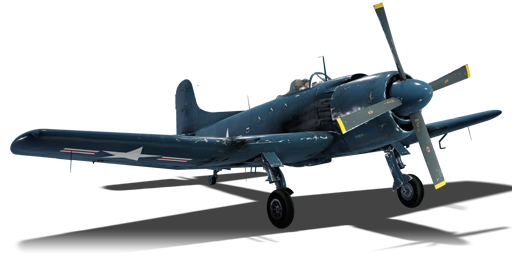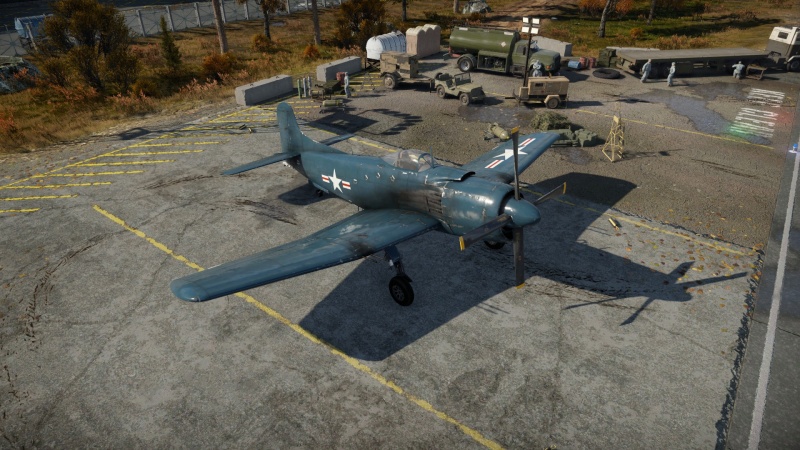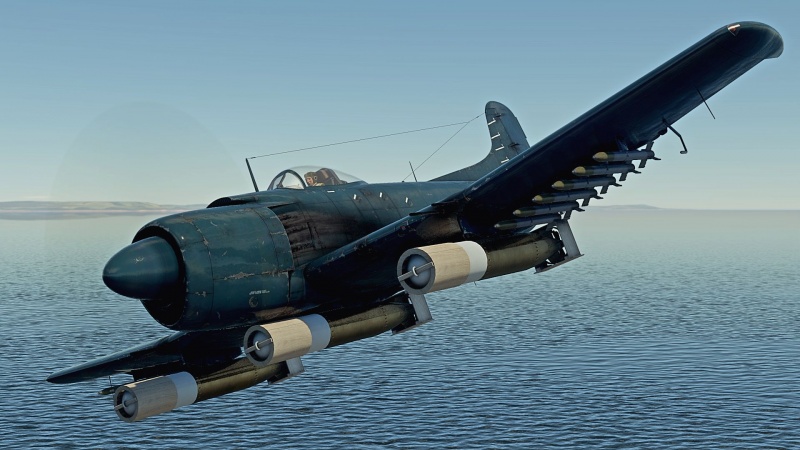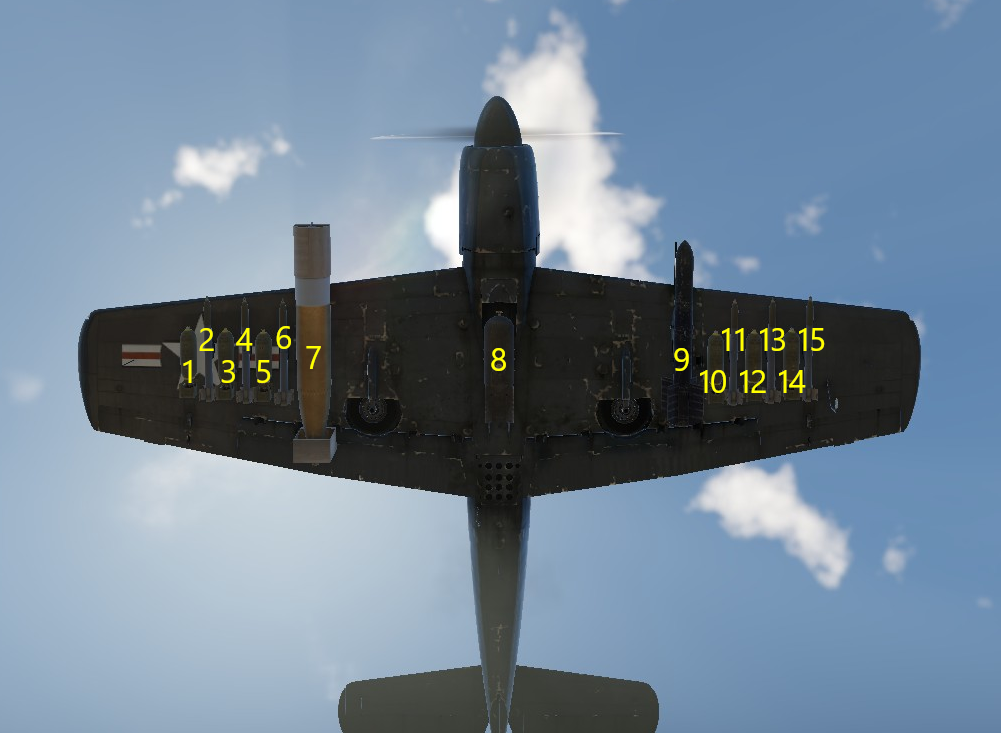Difference between revisions of "AM-1"
(→Pros and cons) (Tag: Visual edit) |
(→Description) |
||
| (5 intermediate revisions by 3 users not shown) | |||
| Line 1: | Line 1: | ||
{{Specs-Card | {{Specs-Card | ||
|code=am_1_mauler | |code=am_1_mauler | ||
| − | |images={{Specs-Card-Image|GarageImage_{{PAGENAME}}.jpg}} | + | |images={{Specs-Card-Image|GarageImage_{{PAGENAME}}.jpg|ArtImage_{{PAGENAME}}.jpg}} |
|cockpit=cockpit_am_1_mauler.jpg | |cockpit=cockpit_am_1_mauler.jpg | ||
}} | }} | ||
| Line 7: | Line 7: | ||
== Description == | == Description == | ||
<!-- ''In the description, the first part should be about the history of and the creation and combat usage of the aircraft, as well as its key features. In the second part, tell the reader about the aircraft in the game. Insert a screenshot of the vehicle, so that if the novice player does not remember the vehicle by name, he will immediately understand what kind of vehicle the article is talking about.'' --> | <!-- ''In the description, the first part should be about the history of and the creation and combat usage of the aircraft, as well as its key features. In the second part, tell the reader about the aircraft in the game. Insert a screenshot of the vehicle, so that if the novice player does not remember the vehicle by name, he will immediately understand what kind of vehicle the article is talking about.'' --> | ||
| − | The ''' | + | The '''Martin AM Mauler''' was a single-engine carrier-based attack aircraft built for the United States Navy. First ordered during World War II in 1944, it was designed to carry as much payload as possible while being capable of operating on an aircraft carrier. After delays due to engine cooling and stability problems, the Mauler entered service in 1948 on board carrier air groups. Because of its impressive payload of up to 4.5 tons, the Mauler was initially nicknamed "Able Mable", however this was superseded by the more derogatory "Awful Monster" by its crews. It suffered problems stemming from excessive torque that resulted in the plane being very sluggish to handle, very hard to land on an carrier (one aircraft even broke its tail during landing due to it being unable to handle its own weight) and its hydraulic fluid that would leak very often, thus making it a maintenance nightmare. In the end, the Mauler was what the USN wanted, but not what they needed, and it would be retired just 5 years later, being replaced by the more capable and reliable [[AD Skyraider (Family)|AD Skyraider]]. |
| − | + | Introduced in [[Update 1.89 "Imperial Navy"]], the {{PAGENAME}} is a classic American attack aircraft. As typical, it is heavy and cumbersome, yet hard-hitting and versatile, due to the weapons it can carry. Don't expect to effectively dogfight in the Mauler as the main purpose of this aircraft is to strike and eliminate the enemy's ground units. The {{PAGENAME}} has the option to outfit HVARS and Tiny Tims rockets and bombs of all sizes depending on the targets to be hit. Enemy fighters should be avoided as they will typically be faster, more manoeuvrable and better equipped for air-to-air combat at which the Mauler is at a significant disadvantage; however, when pressed into air combat, some Mauler pilots may end up working miracles and survive the encounter should they time their turn to face the enemy well enough. | |
== General info == | == General info == | ||
| Line 15: | Line 15: | ||
{{Specs-Avia-Flight}} | {{Specs-Avia-Flight}} | ||
<!-- ''Describe how the aircraft behaves in the air. Speed, manoeuvrability, acceleration and allowable loads - these are the most important characteristics of the vehicle.'' --> | <!-- ''Describe how the aircraft behaves in the air. Speed, manoeuvrability, acceleration and allowable loads - these are the most important characteristics of the vehicle.'' --> | ||
| − | The {{PAGENAME}} is a rather cumbersome and heavy aircraft. For pilots new to the aircraft, they will notice even without a payload, the aircraft feels sluggish and can be even more frustrating early on while the aircraft is still in its stock phase. At low speeds, this aircraft is an easy target to prey on. Despite the circumstances, it is decently manoeuvrable for a single-seated attack aircraft allowing for the targeting of ground targets, however, care must be taken when it is necessary to manoeuvre as this aircraft bleeds energy very quickly. | + | The {{PAGENAME}} is a rather cumbersome and heavy aircraft. For pilots new to the aircraft, they will notice even without a payload, the aircraft feels sluggish and can be even more frustrating early on while the aircraft is still in its stock phase. With powerful Pratt & Whitney R-4360 "Twin Cyclone" engine, the Mauler can accelerate fairly quickly, especially in a dive with payloads. As such, it comes with an airbrakes to help slow down the plane and prevent it from being lawndarted into the ground. |
| + | |||
| + | At low speeds, this aircraft is an easy target to prey on, especially with heavy payload. Despite the circumstances, it is decently manoeuvrable for a single-seated attack aircraft, especially at high speed, allowing for the targeting of ground targets or even catch the enemy fighter off-guard, however, care must be taken when it is necessary to manoeuvre as this aircraft bleeds energy very quickly. | ||
{| class="wikitable" style="text-align:center" width="70%" | {| class="wikitable" style="text-align:center" width="70%" | ||
| Line 196: | Line 198: | ||
* Bleeds energy quickly if manoeuvring | * Bleeds energy quickly if manoeuvring | ||
* Engine overheats fairly quickly | * Engine overheats fairly quickly | ||
| − | |||
== History == | == History == | ||
Latest revision as of 09:49, 1 April 2024
Contents
Description
The Martin AM Mauler was a single-engine carrier-based attack aircraft built for the United States Navy. First ordered during World War II in 1944, it was designed to carry as much payload as possible while being capable of operating on an aircraft carrier. After delays due to engine cooling and stability problems, the Mauler entered service in 1948 on board carrier air groups. Because of its impressive payload of up to 4.5 tons, the Mauler was initially nicknamed "Able Mable", however this was superseded by the more derogatory "Awful Monster" by its crews. It suffered problems stemming from excessive torque that resulted in the plane being very sluggish to handle, very hard to land on an carrier (one aircraft even broke its tail during landing due to it being unable to handle its own weight) and its hydraulic fluid that would leak very often, thus making it a maintenance nightmare. In the end, the Mauler was what the USN wanted, but not what they needed, and it would be retired just 5 years later, being replaced by the more capable and reliable AD Skyraider.
Introduced in Update 1.89 "Imperial Navy", the AM-1 is a classic American attack aircraft. As typical, it is heavy and cumbersome, yet hard-hitting and versatile, due to the weapons it can carry. Don't expect to effectively dogfight in the Mauler as the main purpose of this aircraft is to strike and eliminate the enemy's ground units. The AM-1 has the option to outfit HVARS and Tiny Tims rockets and bombs of all sizes depending on the targets to be hit. Enemy fighters should be avoided as they will typically be faster, more manoeuvrable and better equipped for air-to-air combat at which the Mauler is at a significant disadvantage; however, when pressed into air combat, some Mauler pilots may end up working miracles and survive the encounter should they time their turn to face the enemy well enough.
General info
Flight performance
The AM-1 is a rather cumbersome and heavy aircraft. For pilots new to the aircraft, they will notice even without a payload, the aircraft feels sluggish and can be even more frustrating early on while the aircraft is still in its stock phase. With powerful Pratt & Whitney R-4360 "Twin Cyclone" engine, the Mauler can accelerate fairly quickly, especially in a dive with payloads. As such, it comes with an airbrakes to help slow down the plane and prevent it from being lawndarted into the ground.
At low speeds, this aircraft is an easy target to prey on, especially with heavy payload. Despite the circumstances, it is decently manoeuvrable for a single-seated attack aircraft, especially at high speed, allowing for the targeting of ground targets or even catch the enemy fighter off-guard, however, care must be taken when it is necessary to manoeuvre as this aircraft bleeds energy very quickly.
| Characteristics | Max Speed (km/h at 3,500 m) |
Max altitude (metres) |
Turn time (seconds) |
Rate of climb (metres/second) |
Take-off run (metres) | |||
|---|---|---|---|---|---|---|---|---|
| AB | RB | AB | RB | AB | RB | |||
| Stock | 566 | 547 | 9600 | 23.0 | 23.8 | 10.9 | 10.9 | 170 |
| Upgraded | 617 | 589 | 21.1 | 22.0 | 18.4 | 14.2 | ||
Details
| Features | ||||
|---|---|---|---|---|
| Combat flaps | Take-off flaps | Landing flaps | Air brakes | Arrestor gear |
| ✓ | ✓ | ✓ | ✓ | ✓ |
| Limits | ||||||
|---|---|---|---|---|---|---|
| Wings (km/h) | Gear (km/h) | Flaps (km/h) | Max Static G | |||
| Combat | Take-off | Landing | + | - | ||
| 0 | 700 | 420 | 350 | 300 | ~12 | ~6 |
| Optimal velocities (km/h) | |||
|---|---|---|---|
| Ailerons | Rudder | Elevators | Radiator |
| < 450 | < 220 | < 500 | > 440 |
Survivability and armour
The pilot is protected in the front by 40 mm of bulletproof glass and in the back by 9.5 mm of steel. There are also two 9.5 mm steel plates under the engine and cooling system.
The aircraft has three self-sealing fuel tanks: one behind the pilot, and one in either wing root. Since the fuel tanks are not particularly large, and since they're all located in one location, fuel fires are unlikely in this vehicle. However, if a fire does occur, the centralized location of the tanks near all of the vehicle's critical components means that the fire is not likely to put itself out.
Modifications and economy
Armaments
Offensive armament
The AM-1 is armed with:
- 4 x 20 mm T31 cannons, wing-mounted (200 rpg = 800 total)
Suspended armament
The AM-1 can be outfitted with the following ordnance:
| 1 | 2 | 3 | 4 | 5 | 6 | 7 | 8 | 9 | 10 | 11 | 12 | 13 | 14 | 15 | ||
|---|---|---|---|---|---|---|---|---|---|---|---|---|---|---|---|---|
| 250 lb AN-M57 bombs | 1 | 1 | 1 | 1 | 1 | 1 | 1 | 1 | 1 | 1 | 1 | 1 | 1 | 1 | ||
| 500 lb AN-M64A1 bombs | 1 | 1 | 1 | |||||||||||||
| 1,000 lb AN-M65A1 bombs | 1 | 1 | 1 | |||||||||||||
| 1,600 lb AN-Mk 1 bombs | 1 | 1 | 1 | |||||||||||||
| 2,000 lb AN-M66A2 bombs | 1 | 1 | 1 | |||||||||||||
| HVAR rockets | 1 | 1 | 1 | 1 | 1 | 1 | 1 | 1 | 1 | 1 | 1 | 1 | ||||
| Tiny Tim rockets | 1 | 1 | ||||||||||||||
| 2,216 lb Mk.13-6 Case torpedoes | 1 | 1 | 1 | |||||||||||||
| Type A Mark I mines | 1 | 1 | 1 | |||||||||||||
| Maximum permissible weight imbalance: 1,200 kg | ||||||||||||||||
| Default weapon presets | |
|---|---|
| |
Usage in battles
The AM-1 is a classic attacker, and it will come as no surprise that its manoeuvrability is lacking. It's fine at high speeds, but at low speeds, the aircraft quickly becomes sluggish, even when no payload is equipped. The plane also has poor acceleration and poor manoeuvring energy retention, all of which means that this plane struggles in a dogfight. If the pilot does find themselves in an engagement against a dedicated fighter aircraft, the best thing to do would be to fly towards a teammate who can help.
Where this plane shines is in a ground-attack role. The cannons, when using ground target belts, can take out lightly armoured targets quite effectively, and the high ammo count is certainly a nice bonus. Additionally, this plane receives an incredible number of ordnance options, from HVAR and Tiny Tim rockets to up to 5,000 lbs of bombs. In Air Realistic battles these can destroy the most heavily armoured ground targets, and in Ground Realistic these allow the pilot to achieve 7 kills against enemy ground units without landing to reload.
This plane also receives three torpedoes for use in naval battles.
All in all, the AM-1 is a below-average fighter with incredible anti-ground capabilities. Although sluggish, it more than makes up for it in pure firepower.
Manual Engine Control
| MEC elements | ||||||
|---|---|---|---|---|---|---|
| Mixer | Pitch | Radiator | Supercharger | Turbocharger | ||
| Oil | Water | Type | ||||
| Not controllable | Controllable Auto control available |
Controllable Not auto controlled |
Controllable Auto control available |
Separate | Not controllable 1 gear |
Not controllable |
Pros and cons
Pros:
- Large and versatile payload, with custom loadout options
- Decent 20 mm cannons for head-ons or ground attack purposes
- Reasonably manoeuvrable at medium-to-high speeds
- Airbrakes and arresting hook
- 3 torpedoes in ship battles can cause serious damage to several large ships
Cons:
- No defensive armament
- Sluggish at low speeds, especially with heavy payload
- Poor acceleration
- Bleeds energy quickly if manoeuvring
- Engine overheats fairly quickly
History
Development
In the 1930s and 1940s the Navy had two designations for carrier-based bombers: dive bombers and torpedo bombers, which each had a crew of 2-3 men. It was found during the war that more than 1 crewman was unnecessary, even in combat situations. In addition, if the two classes of naval bombers were combined into one aircraft, it would allow for a carrier's air group to have more flexibility and to increase the amount of fighters on the carrier. The Navy asked for design proposals for a multi-purpose bomber in 1943, and chose 4 designs to continue. These were the Curtiss XBTC, Douglas XBT2D Skyraider, Kaiser-Fleetwings XBTK, and the Martin XBTM. The Navy asked Martin to create a design using the Pratt and Whitney R-4360 Wasp Major engine as a backup to the Curtiss design, which the Navy feared was overly complex.
Design
The XBTM-1 was a low-wing monoplane with folding wings for carrier storage, and conventional landing gear. It featured a single-seat cockpit with a teardrop shaped canopy right behind the engine. There was a 150 gallon fuel tank behind the cockpit. There was a dive break that ran the length of the trailing edge of the wing. The wing design was ideal for dive bombing, because of the large surface area, but the ailerons were much less efficient, as they were not wide. The pilot and oil cooler were protected by heavy armour. The primary armament consisted of four 20 mm T-31 cannons in the wings with 200 rounds per gun. Additional armament was suspended on one centreline hardpoint, and two outer hardpoints. These hardpoints could carry bombs, drop tanks, or torpedoes up to 2,300 pounds. The outer hardpoints could also take an AN/APS-4 search radar pod. 6 hardpoints could be added to the outer wings to carry 500 pound bombs or 5 inch rockets. After testing of the first two prototypes, slight modifications were made to the engine cowling, propeller, rudder, and vertical stabilizer. The BTM-1 was redesignated as the AM-1 in 1946.
Production and Service
The Navy ordered 750 BTM-1s in January of 1945, but changed the order to only 99 after the Japanese surrender in August. After the modifications to the design, and the re-designation to AM-1, deliveries began in March of 1947. A number of issues were found, including a badly laid out cockpit, tailhook issues, elevator control, and structural weakness of the fuselage. These issues were solved and mitigated. The Navy ordered 50 more AM-1s, known as the AM-1 Mauler. An electronic countermeasure version was created, known as the AM-1Q. The AM-1Q added an electronics operator in the fuselage, where the fuel tank used to be. The Mauler was found to be a hard to handle aircraft. It did not do well in carrier landings, and was hard to fly in a formation, plus it had maintenance issues. Despite this, it could carry more ordnance than the AD Skyraider, and was more stable when dive bombing.
The AM-1 was given to squadrons in the Atlantic Fleet. It served for a relatively short amount of time, as although the Skyraider could carry less secondary armament, it flew better, landed better, and was more reliable. In 1950, all Maulers were moved to shore-based squadrons, but they were abandoned in the same year to Naval Reserve squadrons. They were retired from service with the Naval Reserve squadrons in 1953.
Media
- Skins
- Videos
See also
- Aircraft of comparable role, configuration and era
External links
| Glenn L. Martin Company | |
|---|---|
| Attackers | AM-1 |
| Bombers | B-10B · B-26B · PBM-1 · PBM-3 · PBM-5A |
| Jet bombers | B-57A* · B-57B* |
| Export | Martin 139WC · Martin 167-A3 · B-26C |
| * These aircraft were license-built from The English Electric Company Limited who developed and built the British English Electric Canberra. | |
| USA strike aircraft | |
|---|---|
| Douglas | A-20G-25 · A-26B-10 · A-26B-50 · A2D-1 · AD-2 · AD-4 · A-1H |
| North American | A-36 · PBJ-1H · PBJ-1J |
| Other | AM-1 · AU-1 · XA-38 |







